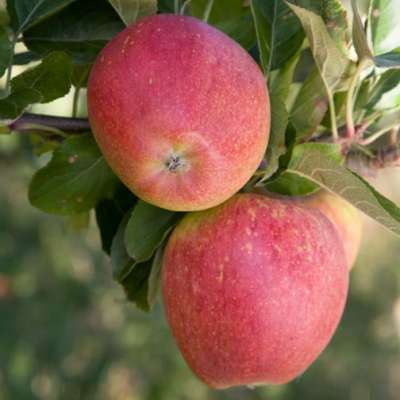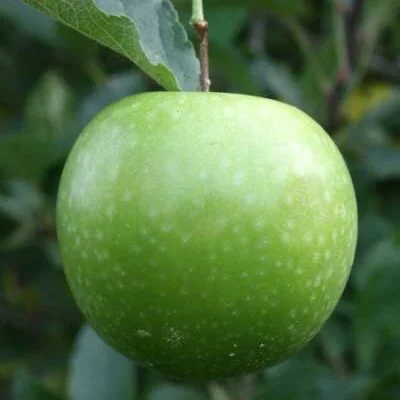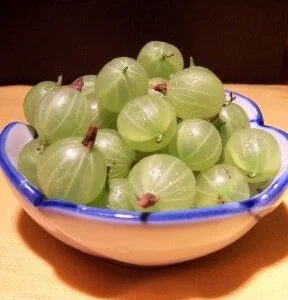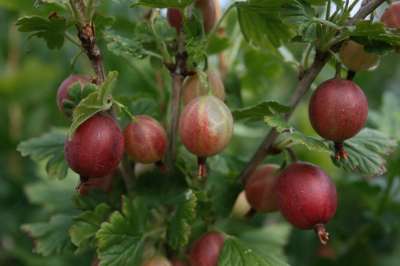Your basket is currently empty!
New PearTrees – buy here….
Aftercare of Pear trees – Pruning
The pruning of pear trees is the same as for apples [if you think about it there is logic here; pear trees pruned the same as apples because they have a pip. Cherries and Plums are pruned the same because they are stone fruit] The pruning procedure you undertake will of course be dictated by the form you want your trees to take.Pruning is necessary not only because it helps shape and control the tree, it is also designed to promote the right kind of growth. Not all growth is fruit-bearing growth. If you prune correctly your tree will come into bearing sooner than a tree that has not been pruned.
PRUNING THE BUSH TREE. The best natural shape of a tree is a bush. The branches spread from a 2 or 3 foot stem and are easy to pick from and prune.
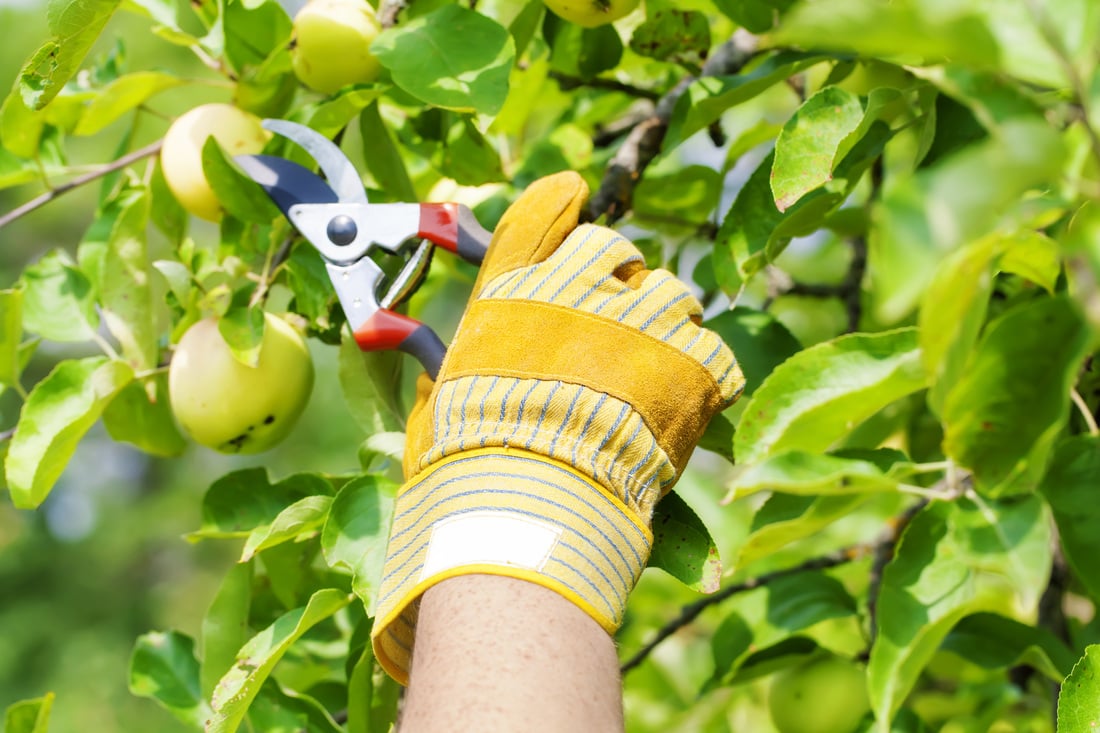
FIRST WINTER. Immediately after planting, if the tree is a maiden, the main stem should be cut just above a bud at approximately 3 feet from the ground and any side shoots cut back to just 2 or 3 buds from the main stem. These young side shoots are called feathers, any that are closer to the ground than 2 feet should be removed.
SECOND WINTER. Or after planting if the tree is two years old. . There will now be 3 or 4 good wide angled shoots which will become the main branches. Cut each of these back to an outward facing bud, removing about half the length of the shoot.
THIRD WINTER. All of the shoots pruned the previous Winter should have grown a further 2 or 3 good shoots. These should be pruned to a well placed bud removing about a third of the new growth, any shoots that have developed and may cause overcrowding should be removed to maintain the bush shape of your tree. The main framework should now consist of about 8 main branches.
PRUNING THE ESTABLISHED TREE. Your tree is now established and will begin to fruit, from now on the pruning is much more flexible. It is simply a matter of removing any unwanted wood that is overcrowding your tree or restricting light and air to too great an extent. In general, the tips of the braches should not now be pruned unless a branch is growing in an undesirable direction. Every year some side shoots should be left un-pruned to bear fruit, cutting out only those that fruited the previous year to a two inch stump. You will now be understanding the growth of your tree and the results of previous pruning and be in a position to cultivate your fruiting tree to provide your requirements.
PRUNING THE DWARF PYRAMID. The dwarf pyramid is the ideal easy way of growing apples and pears if room is restricted in the smaller garden or a very intensive system is required. Trees are planted just 5 feet apart for M9 and 6 feet apart for M26 and pears. If more that one row is required the rows should be 7 feet apart. As the name suggests the aim of pruning a dwarf pyramid is to have a central stem of about 7 feet high and a total branch spread of about 4 feet which tapers to the top to form a pyramid shape. This shape is achieved easily with a combination of Winter and Summer pruning. Do not grow dwarf pyramids against a wall, but in the open garden. After planting, the stems should be cut back to about 20 inches from the ground and any side shoots cut to leave 4 or 5 buds, shorter if necessary. During the first Summer, 4 or 5 strong shoots will be produced, no pruning is required at this time.
THE SECOND WINTER. Cut back the central leader to leave approximately 9 inches of new growth, ensuring that you prune at a bud that points in the opposite direction to the last pruning. This ensures that the central stem will remain as straight and upright as possible. The side branches should be pruned to a downward pointing bud to leave approximately 8 inches of the new seasons growth.
THE FOLLOWING SUMMER, JULY TO AUGUST. Leave all the leaders un-pruned but all the laterals (the current season’s growth) that have grown from trees should be pruned back to about 3 or 4 inches or 3 leaves. Any that are immature leave and prune in September in the same way.
THE THIRD WINTER AND SUBSEQUENT PRUNING. Once again cut back the central leader to about 9 inches ensuring you prune to a bud on the opposite side to the previous Winter. Once the tree has reached the required height of about 7 feet, the leader should not be pruned in Winter but cut back to its origin in Summer. If the growth is vigorous, this can be done in May and further shortened in August.Every Summer the branch leaders should be pruned to approximately 5 inches and all side laterals to 3 or 4 leaves. Any sub laterals (those growing from the side laterals) should be pruned to 2 leaves.From now the intention should be to retain the pyramid shape by close pruning and removal of any over vigorous shoots. Dwarf pyramids are easy to manage and all pruning is at a convenient height. The best form for the smaller modern gardens.
PRUNING CORDONS. After planting cut the main stem to a bud removing about one third, this will often have been done at the nursery, prior to despatch. At planting it is easier to tie the bamboo cane to the support and then tie the stem of the tree to the bamboo cane.
THE FIRST SUMMER. As the main stem grows this should be tied to the supporting bamboo to keep it in a straight line, do not prune this main stem. In July or August prune the laterals which have grown from the main stem leaving 3 or 4 leaves on each. Ignore the ring or cluster of leaves at the base of each stem, count from this cluster and cut close to the selected leaves. It is easy to see when your cordon is ready for Summer pruning, the side shoots have grown out to 9 inches or more long, the leaves have become darker and lost their early brightness and the whole shoots have stiffened and begun to look more mature at the base end near the stem.
FOLLOWING WINTERS PRUNING. Each Winter prune the new growth of the main stem as before until it has reached the required height at the top of the wires. Each year cut at a bud on opposite sides so that the main stem keeps growing as straight as possible. When the main stem has reached the top of the wire, it should no longer be pruned in Winter but cut back in Summer to the required height.
SUMMER PRUNING THE NOW ESTABLISHED TREE. Every Summer at the stage of growth previously described, all of the laterals that are growing from the main stem should be pruned to leave 3 to 4 leaves. Do not prune those less than 9 inches long as these may have fruit buds.All sub laterals (shoots which grow from previous laterals) should be pruned back to two leaves. If secondary growth occurs in poor growing seasons, prune back to one bud from your earlier Summer pruning in September. All of this may sound drastic and complicated but it is not, it is essential and easy, so easy in fact that it has been known in large areas of professional trials to Summer prune with hedging shears. We ourselves still prefer the traditional method!
Subsequent feeding
You should apply fertilizer ideally to an area of soil correspondent to the size of the top growth. If your trees are growing in grass then the fertilizer can be brushed into the grass. If it is not then rake it into the soil lightly.Potash is a good fertilizer to apply, and early Spring is the time to do it. A rate if a bout three quarters if an ounce to a square yard is appropriate. Sulphate of ammonia can be applied additionally during February, applied at 1oz per square yard.
Additional watering for Pear trees
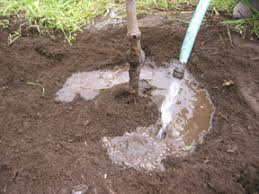
Is of value not only to newly planted or immature trees, but also to established ones. It will increase the yield of the trees considerably as the fruit size will increase and the trees’ will carry more fruits to maturity and not lose so many along the way. Aim to provide additional watering with a hose pipe or a trickle system, in July, August and September. If your trees suffer from biennial cropping – commonplace and certain varieties are more prone than others – then this can also be alleviated by additional irrigation.
Thinning the fruit
During early summer keep an eye on your trees. If it seems like the crop is going to be very abundant then it is a good idea to consider thinning at this time. That might seem like a contradiction, right? You’ve worked hard for this bounty and it seems like your efforts are about to be rewarded and this fool is telling you to wilfully cull some of those tempting, burgeoning fruits? The fact is that during years of over-abundance one of two things will likely happen. Either the trees’ will shed quite a few fruits along the way, of their own accord; or the resulting crop will consist of a lot of small fruits. Neither situation is ideal so by controlling the fruit set you can influence the size of the fruits and also aid the trees’ ability to carry them all to maturity.For fruit thinning you can pinch out the fruits with thumb and forefinger when they are about the size of a marble. Remove one or two baby fruits from each truss rather than removing entire fruit clusters. Or, if you have a lot of patience you can use small sharp scissors.
Supporting branches laden with crop
This tends to be more of an issue with apples than pears, but pears too, especially the larger dessert kinds, can occasionally break a branch through sheer weight of crop. If branches appear to be drooping or strained, support them with branches propped beneath.
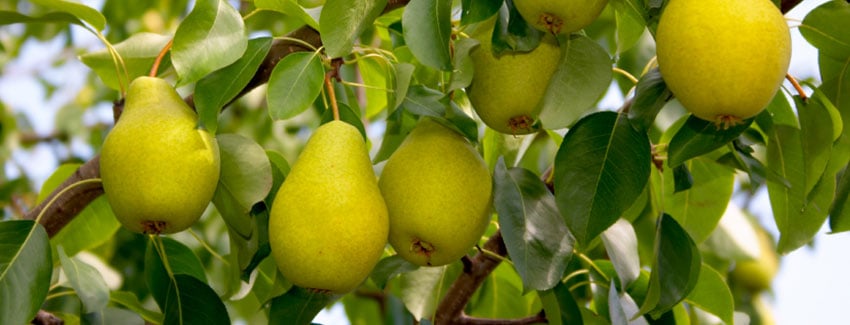
Harvesting
It can be quite difficult to decide when your Pears are actually right for picking and of course it varies a lot with the varieties. Remind yourself when the varieties you chose to plant are in season and use that as a guide. But only a guide; of course it will vary quite a lot with location, siting and also the season. Remember storing pears should normally be left on the tree as late as possible, pick them after the first frosts and continue to ripen them in store. For more regular mid season and early pears, lift the pear in the palm of the hand and tug gently. It should depart from the branch without too much of a fight, or it is not ready.Delicate treatment is required for Pears which can have quite delicate skin and bruise easily. They will then go rotten in double quick time. Not so much of a problem if you are devouring the fruit straight away but not a good thing if you want them to keep.Remember earlies will only last a few days and should be eaten as soon as possible to catch them at their best.Mid season croppers can generally be enjoyed over a few weeks and can be harvested just prior to full ripeness and then kept in cool conditions until required.



